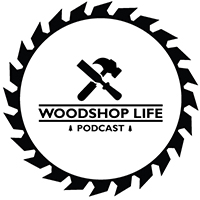Support us on Patreon: https://www.patreon.com/woodshoplife
Guy
1) I’ve been building small furniture projects (Shaker tables, end tables, walnut table, lounge chairs) in my hobby shop using a skill saw or a hand saw when a bandsaw has been called for. My furniture projects are getting more complicated (a dresser, more lounge chairs) and I’m thinking it is time to get a bandsaw. But which one? I don’t see me doing much resawing, although I don’t want to completely foreclose that possibility. I’ve thought about the following options: Jet 14 inch deluxe pro (1.25 hp, $1000), Grizzly GO555LX 14 inch (1 hp, $750), and Rikon table top deluxe 10 inch (0.5 hp, $440). I note that Lowe’s also has a Porter Cable 13 inch and a Delta 13 inch, but at their price point I think I’d be better off with the Grizzly. What are your thoughts? Many thanks. …Tom
2) Hey fellas, big fan of the show. Really enjoy the “specificity” you bring to the craft. Question: you guys talk about not trusting your mitre saws for accurate cross cuts (kapex excluded). So I assume your trusted method is with a table saw. How do you manage getting accurate cuts on large pieces. I know trying to shave a 1/8” off of the end of a 8ft x 6 x 4/4 piece of lumber is not easily done with a mitre jig or a sled on a table saw. How do you get that perfect 90 on something other than a mitre saw on large and long stock? P.S. I don’t trust my mitre saw either. -Zach
Sean
1) I really enjoy the podcast and I always learn a lot listening to your show. My question is about finishing. I have been noticing that several woodworkers that I follow apply a glossy clear coat for the first few layers and then they will finish with a semi-gloss clear coat. What is the purpose of starting with a “shinier” coat and then finish with a “less” shiny coat? Thanks in advance…Josh
2) Love the show, I have heard throughout several episodes of each of you stocking up on hundreds of board feet of lumber for potential future projects. Is there a specific dimension, specifically thickness and length that you typically look for? I’m assuming that in order to achieve a specific width, you can always glue boards together, but for posts or say table legs, is this what you do as well? Or for those specific projects do you just custom order a thicker stock in order to get the desired thickness. Hope my question makes any sense, apologize if it is basic. Keep the episodes coming!! Christopher
Huy
1) I am a retired rocket scientist who now obsesses over furniture rather than missiles which means I take precision to meaningless extremes. I am replacing my 1977 Craftsman with a Powermatic 64B bought sight unseen. I have a Vega 50” fence which I like quite a bit. The Craftsman will be donated to Habitat. Which of the two fences should I send along to Habitat or are they just a horse apiece?
My skill level is intermediate. If at all helpful the items I make are cabinets and tables used either at home or donated for charity auctions. The blade is a WW2, Bench Dog router table for the left wing.
bob
2) if I got one of those EXPENSIVE Forest Woodworker II combination blades (the modified one with a flat bottom cut), would I fall out of love with blade changes? Are they really that much better that I wouldn’t feel the need to change that I do now? I much prefer the cuts I’m getting now with the specific grinds compared to combination blades I’ve used in the past (the better quality “home center” brands).
Is there a time, even with those expensive combination blades, that you all go back to a specifically rip or crosscut blade?
Thanks for any input!
